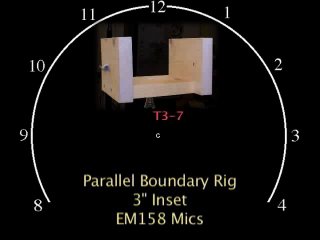Acting on Curt Olson's suggestion, one variable we tested was the distance from the leading edge of our small, head-spaced, parallel boundary rigs to the diaphragm of the Primo EM158 omni-directional capsules. Curt calls this the "setback." We created impulses by striking two large nail "spikes" together in a circle 30 feet away from the mic set-up area. The building was a 100' X 60' wooden barn with a concrete floor. All mic rigs faced the 12 o'clock sound source.
For best results, monitor the following tests with good headphones or near field speaker monitoring.
Here are two QuickTime test movies presenting a progression of four set back distances from three clock positions: 10 o-clock, 12 o-clock and 2 o-clock:
Mic Station 7 Setback Distances: 3" -> 2.5" -> 1.5" -> 1" Large Movie 7mb (48K/16 sound) SMALL Movie 1mb (compressed sound)
Mic Station 14 Setback Distances: 2" -> 1.5" -> 1.0" -> .5" Large Movie 7mb (48K/16 sound) SMALL Movie 1mb (compressed sound)
Next, the same sound samples edited to "toggle" back-and-forth between the maximum and minimum inset distances for both mic stations:
Mic Station 7 Setback Distances: 3" -> 1" Toggle Large Movie 13mb (48K/16 sound) SMALL Movie 2mb (compressed sound)
Mic Station 14 Setback Distances: 2" -> .5" Toggle Large Movie 13mb (48K/16 sound) SMALL Movie 3mb (compressed sound)
To my ears, the nail strikes seem further away at the .5": and 1.0" setback distances compared to the larger distances. This reminded me of omni-directional mic performance in open air, so I added recordings from another rig, this one with front-facing 7" spread omni mics using the same model mic capsules and a single 18" by 18" single cardboard baffle. The sound sources are 30 feet away at 10 0-clock, 12 o-clock and 2 o-clock:
Mic Station 7: 3" Setback -> 1" Setback -> Omni A/B Large Movie 7mb (48K/16 sound) SMALL Movie 1mb (compressed sound)
Mic Station 14: 2" Setback -> .5" Setback -> Omni A/B Large Movie 9mb (48K/16 sound) SMALL Movie 2mb (compressed sound)
Assessments Even with headphones, perceptible differences are subtle at first impression, but with repeated playing, one can detect that the smaller setback distances of .5" and 1.0" seem to create the impression of a larger or more "airy" space.
The left-front corner of the wooden barn has a 18' X 18' walled-in area whereas the right side of the barn is open. The sound impulses created on the right side of the room produce louder, longer reverberations. In the above sonogram, one can see the additional volume (blue and red areas) with the .5" setback and the A/B Baffle impulses over the 2" inset in the third and fourth harmonics of the .5" setback and the fourth and fifth harmonics of the A/B rig. The A/B rig has more brightness at the highest harmonics at 12K Hz and 19Khz. I believe the first strike on the left side with the pronounced 3rd harmonic @5800Hz channel was probably due to a performance difference. Another factor that could be adding to the impression of the spaciousness and with the .5" setback is lower volume of and masking from the 1st and 2nd harmonics at 1700Hz and 3400Hz. I
The low frequency drones of a nearby factory penetrating the walls makes it hard to evaluate differences in spatial rendering below 1700Hz (which is a very important part of the spectrum to study when considering "spaciousness.") There could be less response in the spectrum between ~400-800 Hz with the .5" setback and A/B rigs (see circled areas above), but variations in the background sounds during the test moments makes this too difficult to judge.
Does the shorter inset have a negative impact on localization within the stereo field? It doesn't seem to. It might even be better:
Mic Stations 14: Quick Sweep of All Clock Positions with 2" and .5" Setbacks Large Movie 5mb (48K/16 sound) SMALL Movie 1mb (compressed sound)
Conclusions There's enough performance difference between the short and long setback distances to merit experimenting with this variable in the field. Its too early to suggest that our Parallel Boundary rigs will generally produce more spaciousness in the stereo image with a small sebacks, but the possibility exists. The similarities in performance between these small setback distances and the A/B baffle rig suggest to me that the small setback distances are allowing the capsules to perform more as they would in the open air-iin this case used with a baffle to lessen high Hz cross-over from the other side with a head-like spacing. These traits are common to both the wooden Parallel Boundary and A/B cardboard baffle rigs. Rob D.












